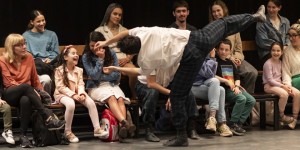IMPRESSIONS: Batsheva Dance Company in Ohad Naharin's "MOMO" at BAM

Ohad Naharin’s MOMO
BAM Howard Gilman Opera House
Mar 6 - 8, 2025
Co-Creators: Batsheva Dance Company Dancers (Season 2022-23) + Ariel Cohen
Performers: 11 Batsheva Dance Company Dancers (Season 2024-25)
Yarden Bareket, Adi Blumenreich, Emil Brukman, Nathan Chipps, Holden Cole, Guy Davidson, Iyar Elezra, Sean Howe, Londiwe Khoza, Adrienne Lipson, Bo Matthews, Eri Nakamura, Sofiia Pikalova, Danai Porat, Igor Ptashenchuk, Yoni (Yonatan) Simon, Annika Verplancke, Gili Yaniv Amodai, Yarden Zana
When I arrive at the Brooklyn Academy of Music’s Howard Gilman Opera House, “Dancers for Palestine” are protesting peacefully at the entrance. Guards ask about the contents of my bag, and inquire what is in my coat and pants pockets. Only after being scanned and padded down, am I allowed to enter the lobby. The state-funded Batsheva comp
Choreographer Ohad Naharin’s MOMO sneaks up on you, when four men traverse the stage from upstage right with the house lights still on.They wear grey cargo pants, and turn to face the now quiet audience as they slowly march in sync toward the apron. But they stay within the confines of the stage, and walk across the front with deliberate steps. Their articulate, bare feet and defined torsos fascinate me. But soon, other dancers enter the space and divert my gaze.

This company of eleven dancers presents two planes of existence. Seven dancers follow individual paths, while a group of four suggests a modern version of a Greek Chorus. If an ancient chorus sometimes comments on the morality of the action, and even describes offstage crimes, these four men simply center one’s focus through their unified movements. The exquisitely performed, self-

The beauty of Laurie Anderson’s music Landfall, for the Kronos Quartet, anchors the disjointed schizophrenia of these two tribes, who move in close proximity without acknowledging each other. It is heartening that tender care defines much of the movement material for the community of four men, who, at one point, ascend a back wall inserting their hands and feet in unobtrusive crevices. They observe the action from elevated seats, and make me think of gods looking down at mankind’s follies. The seven dancers bel

Not every image is powerful, or evokes a reference, but the bounty of imagery overwhelms and comforts me at the same time. This dance is grander than I can process, just as life presents more riches than anyone could cherish. While I am hoping for answers, many questions arise. Are the performers’ raised hands an invitation to discourse, or do the hands signify the number of bombings suggested by repeated exploding sounds?
The dancers congregate on the apron of the stage as if to communicate with the audience, but then turn away and get lost in inconsequential solos. I am frustrated by this non-conclusion, but uplifted by the inventive beauty of the dancing throughout the evening. One can hope that peaceful coexistence will one day be possible for the people of Palestine and Israel.















